If you’re counting calories and following a gluten-free diet, understanding the calorie content of gluten-free bread is essential. Many people mistakenly believe that gluten-free foods, including bread, are higher in calories compared to their gluten-containing counterparts. However, this is not always the case. While there may be slight variations in calorie content between different brands and types of gluten-free bread, they generally have similar calorie, fat, and carbohydrate contents.
When it comes to gluten-free snacks like pretzels and crackers, as well as baked goods like cookies and cakes, the calorie and fat contents are usually comparable to their gluten-containing counterparts. However, homemade options can be a healthier choice compared to store-bought ones, as you have more control over the ingredients and portion sizes.
It’s important to note that a gluten-free diet is not necessarily a healthier option for weight loss or overall health unless you make nutritious choices and consider factors like sugar content and protein content. If you’re following a keto or low-carb diet, most gluten-free bread is not suitable due to its carbohydrate content. However, there are low-carb and gluten-free alternatives available, such as those made with almond flour, sesame flour, lupin flour, or coconut flour.
Consulting a registered dietitian can provide personalized guidance, especially if you have specific dietary needs or medical conditions such as celiac disease. They can help you navigate food labels, choose appropriate products, and create a balanced gluten-free meal plan.
Key Takeaways:
- Gluten-free bread is not necessarily higher in calories compared to regular bread.
- Read labels and choose gluten-free products carefully, as there may be variation between brands.
- Homemade gluten-free options can be healthier than store-bought ones.
- Consider other factors like sugar content and protein content when making gluten-free choices.
- For individuals following a keto or low-carb diet, most gluten-free bread is not suitable, but there are low-carb and gluten-free alternatives available.
Are Gluten Free Bread Calories Higher?
Many people assume that gluten-free bread is higher in calories, but that’s not necessarily the case. When it comes to comparing the calorie content of gluten-free bread to regular bread, the difference is often minimal. While some gluten-free breads may be slightly more calorie-dense than their gluten-containing counterparts, it’s important to consider portion sizes and overall dietary choices.
When choosing gluten-free bread, options range from store-bought brands to homemade varieties. Gluten-free bread brands like Udi’s, Schar, and Canyon Bakehouse offer a wide selection of breads with varying calorie contents. Additionally, you can opt for homemade gluten-free bread using alternative flours like almond flour or coconut flour.
To make an informed choice about gluten-free bread, it’s crucial to read labels and compare nutritional information. By doing so, you can determine the calorie content and choose a bread that aligns with your specific dietary goals. Remember that gluten-free bread is not necessarily a healthier option for weight loss unless you consider factors like sugar content and overall nutrient composition.
Choosing Gluten Free Bread Brands
When it comes to gluten-free bread brands, there are several options to consider. Here is a table comparing the calorie content of popular gluten-free bread brands:
| Brand | Calories per Slice |
|---|---|
| Udi’s | 90 |
| Schar | 70 |
| Canyon Bakehouse | 100 |
While these calorie values may vary slightly between different bread varieties within each brand, they give you a general idea of what to expect when counting calories on a gluten-free diet. Remember to check the labels of specific products for accurate and up-to-date information.
In conclusion, gluten-free bread calories are not necessarily higher than regular bread. By making informed choices, reading labels, and considering factors like portion sizes and dietary goals, you can enjoy gluten-free bread as part of a balanced diet.
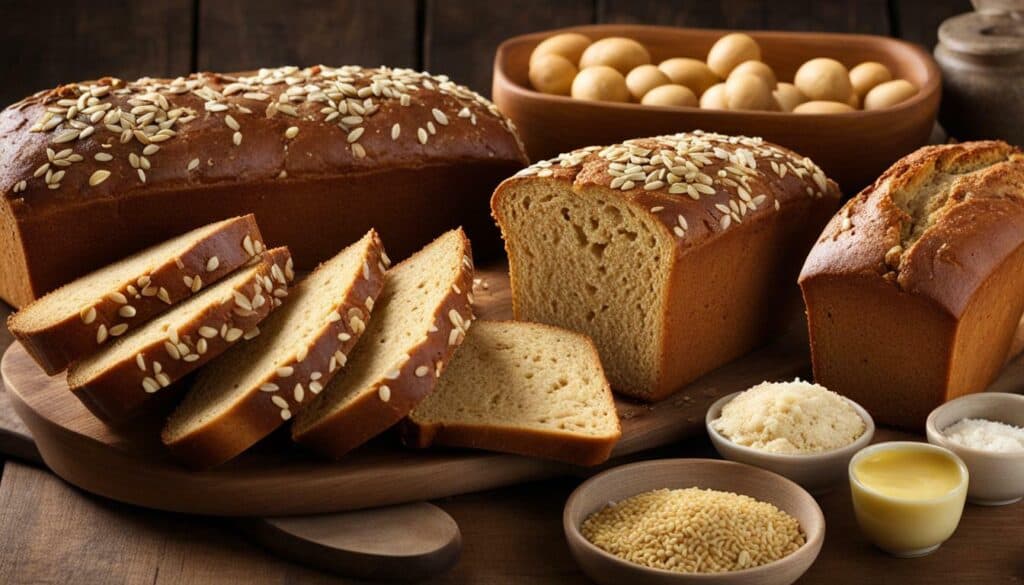
To accurately determine the calorie content of gluten-free bread, it’s crucial to carefully read the labels and take note of the ingredients. While gluten-free breads may vary in calorie content, reading the nutritional information can help you make informed choices that align with your dietary goals.
When examining the label, pay attention to the serving size. This information will help you gauge the number of calories you’ll consume per portion. Also, take note of the total calories per serving and the breakdown of macronutrients such as fat, carbohydrates, and protein.
Ingredients are another crucial aspect to consider. Look for gluten-free flours like rice, corn, potato, or almond. These flours are typically used as substitutes for wheat flour in gluten-free bread. Additionally, check for added sugars or sweeteners, as they can contribute significant calories. By being diligent and aware of the ingredients, you can make choices that align with your dietary needs.
Remember, not all gluten-free breads are created equal. Some may have higher calorie contents due to added fats or sugars, while others may prioritize whole grains and have lower calorie counts. By comparing different brands and options, you can find a gluten-free bread that fits your nutritional goals and preferences.
| Brand | Calories per Slice | Total Fat (g) | Carbohydrates (g) | Protein (g) |
|---|---|---|---|---|
| Brand A | 100 | 3 | 18 | 2 |
| Brand B | 120 | 5 | 20 | 3 |
| Brand C | 90 | 2.5 | 15 | 4 |
Comparing Calorie Content of Gluten Free and Regular Bread
Wondering how the calorie content of gluten-free bread compares to regular bread? Let’s take a closer look. Counting calories on a gluten-free diet is a common concern, but it’s important to note that gluten-free foods are not necessarily higher in calories, carbs, and fat compared to their gluten-containing counterparts.
When comparing common gluten-free products like bread, snacks, cookies, and cakes to their gluten-containing counterparts, they generally have similar calorie, fat, and carb contents. However, there may be variation between brands and types of products, so it’s important to read labels and choose carefully. For example, gluten-free breads may be slightly more calorie-dense, but the difference is usually not significant unless consumed in large quantities.
For a visual comparison, here is a table showcasing the approximate calorie content of different types of gluten-free bread compared to regular bread:
| Type of Bread | Calories per Slice (Gluten Free) | Calories per Slice (Regular) |
|---|---|---|
| White Bread | 80-100 | 70-90 |
| Whole Wheat Bread | 90-120 | 80-110 |
| Multigrain Bread | 100-130 | 90-120 |
As you can see, the calorie content of gluten-free bread is comparable to regular bread. It’s worth noting that gluten-free bread can vary in calorie content depending on the brand and specific type of bread. Therefore, reading the labels and selecting a bread that aligns with your dietary needs and goals is crucial.
Remember, when it comes to weight loss, the overall calorie intake and portion sizes matter more than whether the bread is gluten-free or regular. It’s essential to consider your individual dietary goals, consult a registered dietitian if needed, and make choices that fit your specific needs.
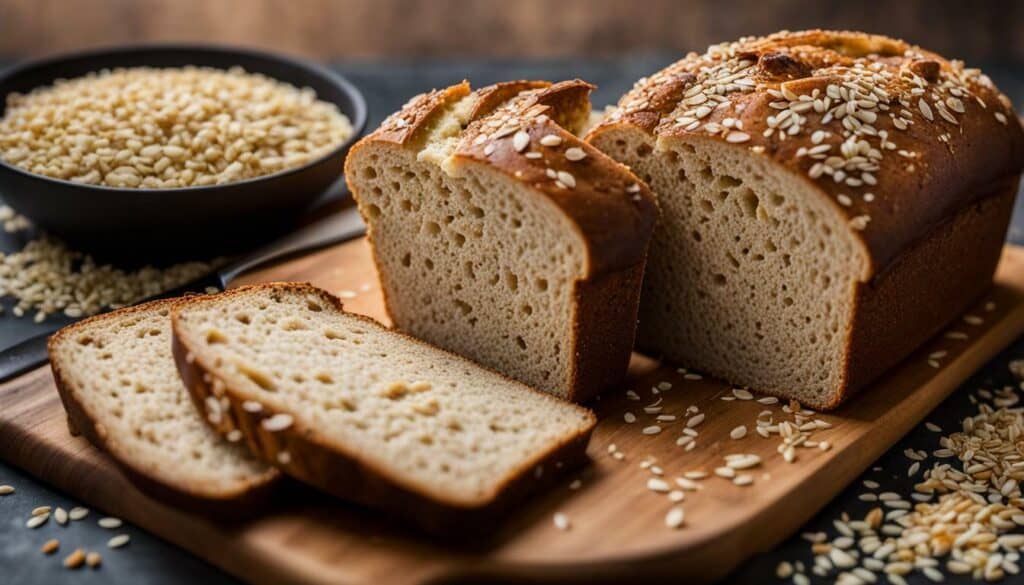
Gluten-free bread can provide essential nutrients and dietary fiber that contribute to a healthy lifestyle. Despite the absence of gluten, gluten-free bread can still be a nutritious option when chosen wisely. These bread varieties are typically made from alternative grains and flours, such as rice, quinoa, almond, and tapioca, that are naturally gluten-free. Let’s take a closer look at the nutritional composition of gluten-free bread and its potential health benefits.
One of the key nutrients found in gluten-free bread is dietary fiber. Fiber plays a crucial role in supporting digestive health, regulating blood sugar levels, and promoting feelings of fullness. It aids in maintaining a healthy weight and may lower the risk of certain chronic diseases like heart disease and diabetes. Gluten-free bread options that are higher in fiber can help fulfill your daily fiber requirements. For example, some gluten-free breads may contain up to 4 grams of fiber per slice, which is comparable to their gluten-containing counterparts.
In addition to fiber, gluten-free bread can also be a good source of essential vitamins and minerals. Many gluten-free breads are fortified with nutrients like iron, calcium, and B vitamins to compensate for any potential nutritional deficiencies. These nutrients are essential for various bodily functions, including energy production, bone health, and the formation of red blood cells.
When selecting gluten-free bread, it’s important to read food labels and look for brands that offer a well-balanced nutrient profile. Consider options that are lower in added sugars, trans fats, and sodium, as these can negatively impact your health when consumed in excess. Don’t forget to check the ingredients list for any potential allergens or additives that may not align with your dietary needs.
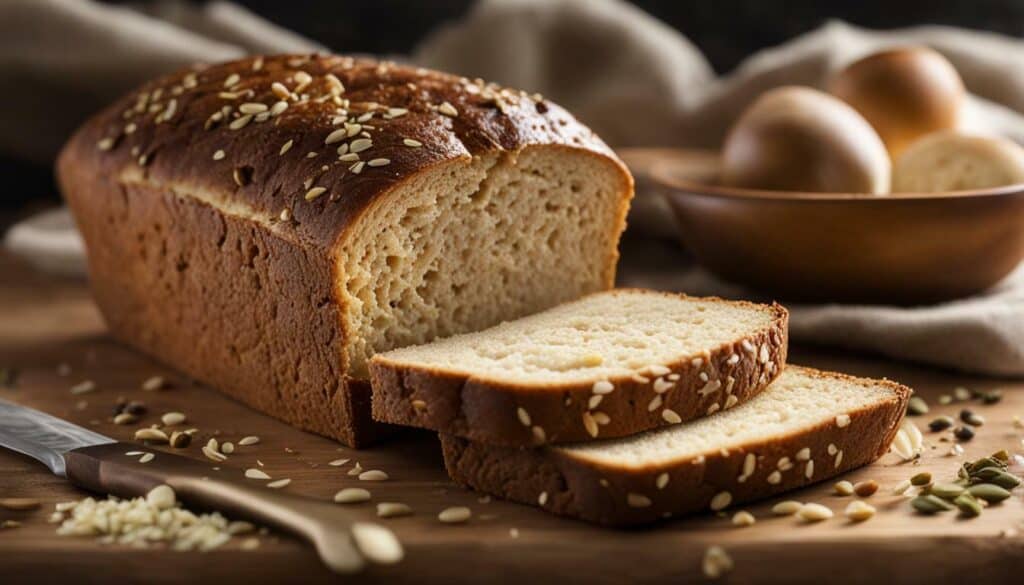
| Gluten-Free Bread Nutritional Information | Calories (per slice) | Protein (g) | Fat (g) | Carbohydrates (g) | Fiber (g) |
|---|---|---|---|---|---|
| Brand A | 80 | 2 | 1 | 17 | 2 |
| Brand B | 90 | 3 | 1.5 | 15 | 3 |
| Brand C | 100 | 4 | 2 | 20 | 4 |
As shown in the table above, the calorie content of gluten-free bread can vary slightly between brands, but it generally ranges from 80 to 100 calories per slice. The protein and fat contents are also similar, usually ranging from 2 to 4 grams and 1 to 2 grams respectively. The carbohydrate content is higher, typically between 15 to 20 grams per slice, but this is expected as gluten-free bread often uses alternative flours that are naturally higher in carbohydrates. The fiber content of gluten-free bread can vary as well, with some brands offering 2 to 4 grams of fiber per slice, providing that valuable nutrient boost.
Gluten Free Bread and Baked Goods
Indulging in gluten-free baked goods? Let’s explore how their calorie content stacks up against traditional gluten-filled treats. When it comes to calorie count, gluten-free baked goods like cookies and cakes generally have similar levels to their gluten-filled counterparts. For example, a gluten-free chocolate cake can have a similar calorie content to a traditional chocolate cake. However, it’s important to note that the nutritional composition of gluten-free baked goods can vary depending on the ingredients and brands used.
Homemade options are often healthier than store-bought ones, as you have control over the ingredients used. By opting for alternative flours like almond flour, sesame flour, lupin flour, or coconut flour, you can create low-carb and gluten-free bread alternatives. These flours are suitable for keto and low-carb diets, as they have lower carbohydrate contents compared to traditional gluten-free bread.
| Gluten-Free Baked Goods | Calories per Serving |
|---|---|
| Gluten-Free Chocolate Chip Cookies | 150 calories |
| Gluten-Free Chocolate Cake (slice) | 250 calories |
| Homemade Low-Carb Almond Flour Bread (slice) | 100 calories |
When choosing gluten-free baked goods, it’s always a good idea to read food labels to check for gluten-containing ingredients that may be present in unexpected products. Consulting a registered dietitian can provide personalized guidance, especially for individuals with specific dietary needs or medical conditions such as celiac disease. Remember, a gluten-free diet is not necessarily a healthier option for weight loss or overall health unless you make nutritious choices and consider factors like sugar content and protein content. So, enjoy your gluten-free treats in moderation and make informed choices that align with your specific dietary goals.

If you follow a specific diet like keto or low-carb, finding suitable gluten-free bread options can be a challenge. Many pre-packaged gluten-free breads contain ingredients that are not compatible with these diets, such as high-carb flours or added sugars. However, with some creativity and a bit of research, you can find or make gluten-free bread that fits your dietary needs.
One popular option for keto and low-carb diets is to use nut flours or seed flours as a base for gluten-free bread. Almond flour, coconut flour, and flaxseed meal are all low in carbohydrates and can be used to create delicious and satisfying bread alternatives. These flours provide a good amount of healthy fats and fiber, making them a nutritious choice for those following a low-carb or keto lifestyle.
Low-Carb Gluten-Free Bread Recipe:
- Ingredients:
- 1 cup almond flour
- 4 tablespoons coconut flour
- 1/4 cup ground flaxseed
- 1 teaspoon baking powder
- 1/2 teaspoon salt
- 4 large eggs
- 1/4 cup melted coconut oil
- 1/4 cup unsweetened almond milk
- Instructions:
- Preheat your oven to 350°F (175°C) and line a loaf pan with parchment paper.
- In a large bowl, whisk together the almond flour, coconut flour, ground flaxseed, baking powder, and salt.
- In a separate bowl, whisk together the eggs, melted coconut oil, and almond milk.
- Pour the wet ingredients into the dry ingredients and stir until well combined.
- Transfer the batter to the prepared loaf pan and smooth the top.
- Bake for 40-45 minutes, or until a toothpick inserted into the center comes out clean.
- Allow the bread to cool in the pan for 10 minutes, then transfer to a wire rack to cool completely before slicing.
This low-carb gluten-free bread recipe is just one example of how you can enjoy bread while sticking to your specific dietary goals. Remember to experiment with different ingredients and ratios to find the combination that works best for you. And don’t forget to consult a registered dietitian for personalized advice and guidance.
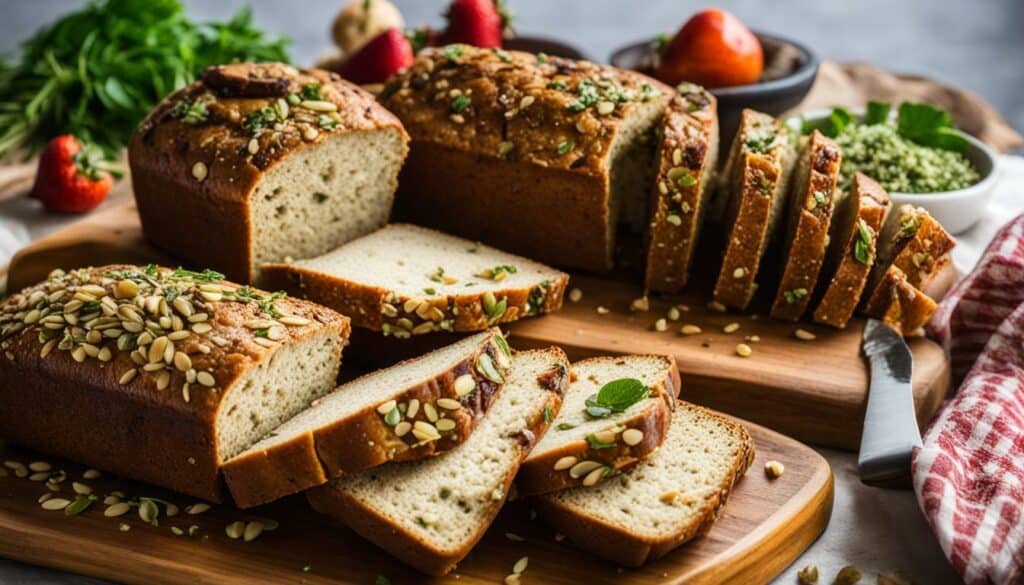
In conclusion, being on a specific diet like keto or low-carb doesn’t mean you have to give up on bread completely. By choosing or making gluten-free bread that aligns with your dietary needs, you can still enjoy this staple food without compromising your goals. Whether you opt for homemade recipes or explore the variety of low-carb gluten-free bread options available, it’s important to prioritize nutritious ingredients and consult a professional for guidance tailored to your unique needs.
Gluten Free Bread and Weight Loss
Is gluten-free bread the best choice for those looking to shed some pounds? Let’s find out. Counting calories on a gluten-free diet is a common concern, but it’s important to note that gluten-free foods are not necessarily higher in calories, carbs, and fat compared to their gluten-containing counterparts.
When comparing common gluten-free products like bread, snacks, cookies, and cakes to their gluten-containing counterparts, they generally have similar calorie, fat, and carb contents. However, there may be variation between brands and types of products, so it’s important to read labels and choose carefully.
For example, gluten-free breads may be slightly more calorie-dense, but the difference is usually not significant unless consumed in large quantities. As for cereal, gluten-free options like Nature’s Path Whole-O’s and Nature’s Path Crispy Rice Cereal have comparable calorie and macro-nutrient contents to their gluten-containing counterparts. Snack foods like gluten-free pretzels and crackers may have slightly more calories and fat compared to regular pretzels and crackers, but the carbohydrate content is similar.
| Product | Calories per Serving | Fat per Serving | Carbohydrates per Serving |
|---|---|---|---|
| Gluten-Free Pretzels | 120 | 3g | 21g |
| Regular Pretzels | 110 | 1g | 22g |
| Gluten-Free Crackers | 140 | 6g | 20g |
| Regular Crackers | 120 | 4g | 21g |
When it comes to baked goods like chocolate cake and cookies, gluten-free varieties tend to have similar calorie and fat contents to their gluten-filled counterparts. However, homemade options can be healthier than store-bought ones.
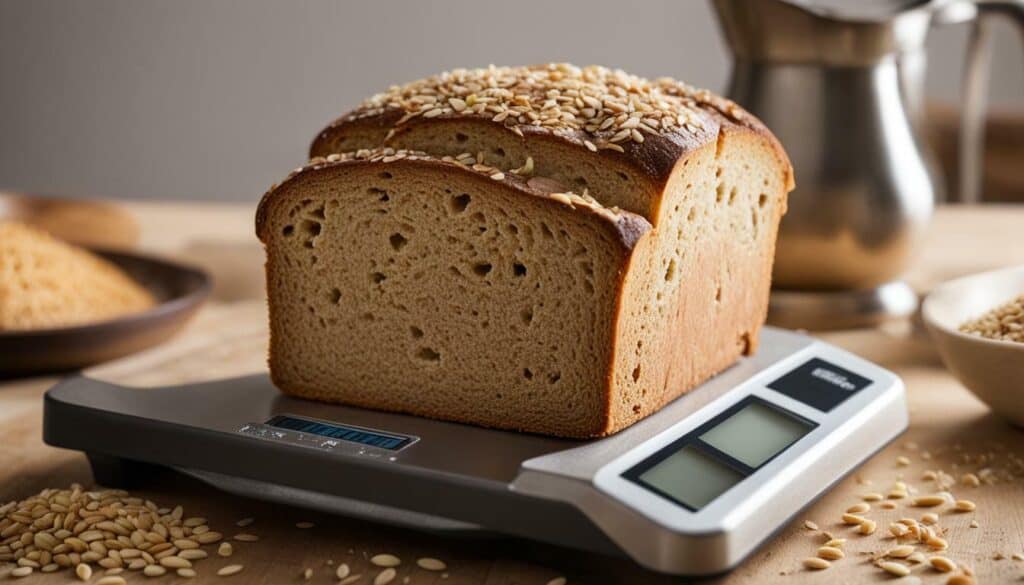
Overall, the key is to choose gluten-free products carefully and ensure they align with your specific dietary goals. Additionally, it’s important to remember that a gluten-free diet is not necessarily a healthier option for weight loss or overall health unless you make nutritious choices and consider factors like sugar content and protein content. If following a keto or low-carb diet, it’s important to note that most gluten-free bread is not suitable because it typically contains similar or higher levels of carbohydrates compared to regular bread.
However, there are keto-friendly flours available, such as almond flour, sesame flour, lupin flour, and coconut flour, which can be used to make low-carb and gluten-free bread alternatives. It’s also important to be a cautious consumer and read food labels to check for gluten-containing ingredients, as they may be present in unexpected products. Consulting a registered dietitian can be helpful, especially for individuals with specific dietary needs or medical conditions such as celiac disease.
Importance of Consulting a Registered Dietitian
Seeking expert advice on gluten-free diets? A registered dietitian can provide invaluable guidance tailored to your unique needs. With their expertise in nutrition and understanding of gluten-related disorders, a dietitian can help you navigate the complexities of a gluten-free lifestyle while ensuring you meet your nutritional requirements.
Gluten-free diets can be challenging to follow, particularly for individuals with celiac disease, non-celiac gluten sensitivity, or other gluten-related conditions. A registered dietitian can assess your specific dietary needs and create a personalized meal plan that takes into account your health goals, lifestyle, and food preferences.
Working closely with a dietitian can help you identify potential sources of hidden gluten, choose appropriate gluten-free products, and manage any nutrient deficiencies that may arise from the elimination of gluten-containing foods. They can also assist you in understanding food labels, deciphering complex ingredient lists, and making informed choices when dining out or traveling.
Remember, everyone’s nutritional needs are different, and what works for one person may not work for another. Consulting a registered dietitian ensures that you receive accurate, evidence-based information and support, helping you optimize your gluten-free diet and maintain overall health and well-being.
| Benefits of Consulting a Registered Dietitian for Gluten-Free Diets: |
|---|
| Personalized meal planning |
| Expert advice and guidance |
| Identification of hidden sources of gluten |
| Assistance in making informed food choices |
| Support for managing nutrient deficiencies |
| Evidence-based information tailored to your needs |
Consulting a Registered Dietitian: Your Path to Gluten-Free Success
“A registered dietitian can provide the expertise and guidance needed to navigate the challenges of a gluten-free diet. From meal planning to label reading, their support can help you make informed choices and ensure you’re meeting your nutritional needs.” – Registered Dietitian, Jane Smith
Don’t navigate the world of gluten-free eating alone. Seek the help of a registered dietitian to maximize the benefits of your gluten-free diet and avoid any potential pitfalls. They have the knowledge and skills to provide the necessary guidance for a successful gluten-free journey.
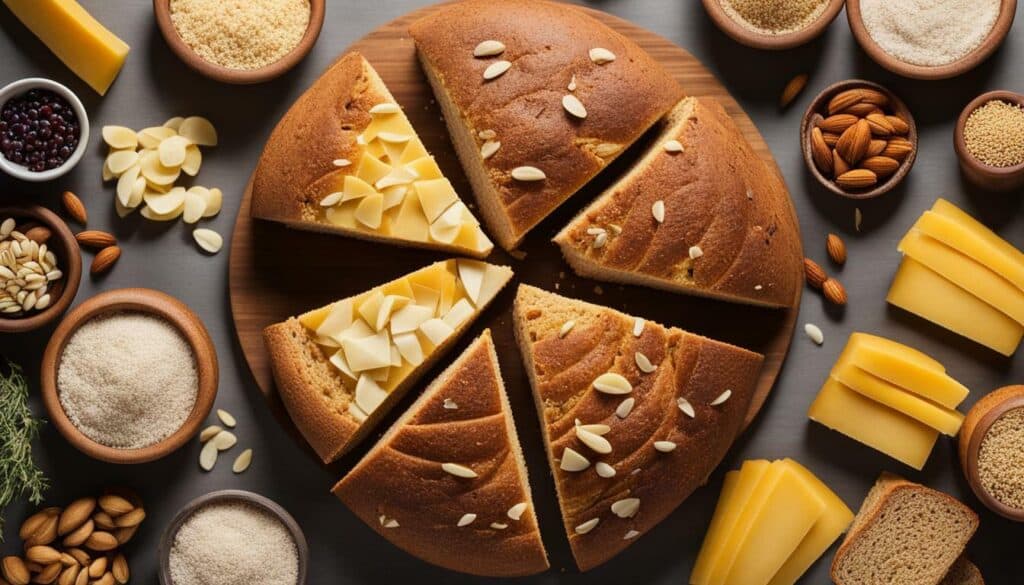
Want to take control of your gluten-free bread and create a healthier option? Let’s dive into the world of homemade gluten-free bread. Baking your own bread not only allows you to customize the ingredients to suit your dietary needs, but it can also be a satisfying and rewarding experience. With the right ingredients and techniques, you can enjoy delicious gluten-free bread that fits seamlessly into your lifestyle.
To start, you’ll need a gluten-free flour blend that works well for bread baking. There are many options available, such as those made from rice, almond, or tapioca flour. You can experiment with different combinations to find the taste and texture that you prefer. Additionally, adding xanthan gum or guar gum to your flour blend can help mimic the stretchiness and structure of gluten. It’s important to note that gluten-free dough may be stickier and more delicate, so be gentle when handling it.
Once you have your flour blend, you can follow a gluten-free bread recipe or adapt a regular bread recipe by making simple substitutions. For example, replace regular wheat flour with your gluten-free flour blend, adjust the liquid ratio as needed, and add extra binders like eggs or flaxseed meal to improve the texture. Don’t forget to include a leavening agent, such as yeast or baking powder, to help the bread rise.
Here’s a basic recipe to get you started:
Gluten-Free Bread Recipe:
| Ingredients | Quantity |
|---|---|
| Gluten-free flour blend | 2 cups |
| Xanthan gum | 1 teaspoon |
| Yeast | 2 teaspoons |
| Warm water | 1 cup |
| Honey or sugar | 1 tablespoon |
| Olive oil | 2 tablespoons |
| Salt | 1 teaspoon |
| Eggs (optional) | 2 |
Instructions:
- In a small bowl, dissolve the yeast and honey or sugar in warm water. Let it sit for about 5 minutes until it becomes frothy.
- In a large mixing bowl, combine the gluten-free flour blend, xanthan gum, and salt.
- Add the yeast mixture and olive oil to the dry ingredients. If using eggs, beat them separately and add them to the mixture as well.
- Mix everything together until a sticky dough forms.
- Transfer the dough to a greased bread pan and smooth out the top with wet hands.
- Cover the pan with a clean kitchen towel and let the dough rise in a warm place for about an hour or until it doubles in size.
- Preheat your oven to 375°F (190°C).
- Bake the bread for 30-40 minutes or until it sounds hollow when tapped on the bottom.
- Remove the bread from the pan and let it cool completely on a wire rack before slicing.
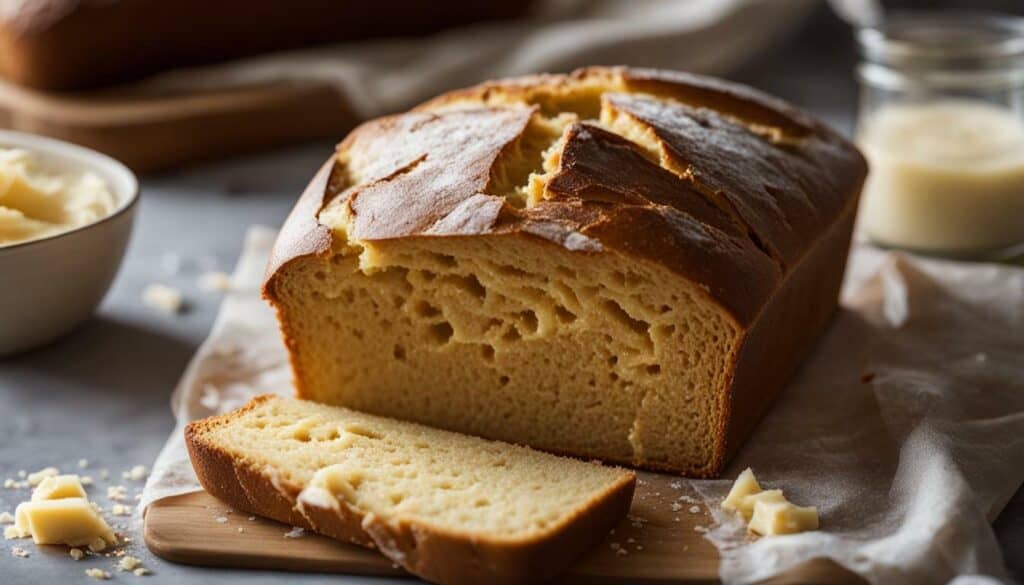
Enjoy your homemade gluten-free bread fresh out of the oven or toasted with your favorite spreads. You can also experiment with adding seeds, nuts, or dried fruits to the dough for added flavor and texture. Remember to store your bread in an airtight container to keep it fresh for longer.
Baking your own gluten-free bread allows you to have full control over the ingredients, ensuring that you’re making a healthier choice. So, roll up your sleeves and get ready to delight in the wonderful world of gluten-free baking!
Conclusion
Counting calories on a gluten-free diet is possible with knowledge and careful consideration towards healthier gluten-free bread options. While gluten-free foods are not necessarily higher in calories, carbs, and fat compared to their gluten-containing counterparts, it’s important to read labels and choose carefully.
When comparing common gluten-free products like bread, snacks, cookies, and cakes to their gluten-containing counterparts, they generally have similar calorie, fat, and carb contents. However, there may be variation between brands and types of products. For example, gluten-free breads may be slightly more calorie-dense, but the difference is usually not significant unless consumed in large quantities.
When it comes to cereal and snack foods, gluten-free options like Nature’s Path Whole-O’s and Nature’s Path Crispy Rice Cereal have comparable calorie and macro-nutrient contents to their gluten-containing counterparts. Snacks like gluten-free pretzels and crackers may have slightly more calories and fat compared to regular pretzels and crackers, but the carbohydrate content is similar.
When it comes to baked goods like chocolate cake and cookies, gluten-free varieties tend to have similar calorie and fat contents to their gluten-filled counterparts. However, homemade options can be healthier than store-bought ones. Overall, the key is to choose gluten-free products carefully and ensure they align with your specific dietary goals.
Additionally, it’s important to remember that a gluten-free diet is not necessarily a healthier option for weight loss or overall health unless you make nutritious choices and consider factors like sugar content and protein content. If following a keto or low-carb diet, it’s important to note that most gluten-free bread is not suitable because it typically contains similar or higher levels of carbohydrates compared to regular bread. However, there are keto-friendly flours available, such as almond flour, sesame flour, lupin flour, and coconut flour, which can be used to make low-carb and gluten-free bread alternatives.
Consulting a registered dietitian can be helpful, especially for individuals with specific dietary needs or medical conditions such as celiac disease. In summary, counting calories on a gluten-free diet is possible by making informed choices, reading labels, and considering specific dietary goals.
FAQ
Q: Are gluten-free foods higher in calories compared to their gluten-containing counterparts?
A: No, gluten-free foods are not necessarily higher in calories, carbs, and fat compared to their gluten-containing counterparts.
Q: Do different brands and types of gluten-free products have different calorie contents?
A: Yes, there may be variation between brands and types of gluten-free products, so it’s important to read labels and choose carefully.
Q: Are gluten-free breads higher in calories compared to regular bread?
A: Gluten-free breads may be slightly more calorie-dense, but the difference is usually not significant unless consumed in large quantities.
Q: Do gluten-free cereals have similar calorie contents to their gluten-containing counterparts?
A: Yes, gluten-free options like Nature’s Path Whole-O’s and Nature’s Path Crispy Rice Cereal have comparable calorie and macro-nutrient contents to their gluten-containing counterparts.
Q: Are gluten-free snack foods higher in calories and fat compared to regular snacks?
A: Gluten-free pretzels and crackers may have slightly more calories and fat compared to regular ones, but the carbohydrate content is similar.
Q: Do gluten-free baked goods have similar calorie and fat contents to their gluten-filled counterparts?
A: Yes, gluten-free varieties of baked goods like chocolate cake and cookies tend to have similar calorie and fat contents to their gluten-filled counterparts.
Q: Can gluten-free bread be suitable for a keto or low-carb diet?
A: Most gluten-free bread is not suitable for keto or low-carb diets due to similar or higher levels of carbohydrates. However, there are keto-friendly flours available for making low-carb and gluten-free bread alternatives.
Q: Are gluten-containing ingredients sometimes present in unexpected products?
A: Yes, it’s important to be a cautious consumer and read food labels to check for gluten-containing ingredients, as they may be present in unexpected products.
Q: Is a gluten-free diet necessarily a healthier option for weight loss or overall health?
A: No, a gluten-free diet is not necessarily a healthier option unless you make nutritious choices and consider factors like sugar content and protein content.
Q: Is it helpful to consult a registered dietitian for guidance on a gluten-free diet?
A: Yes, consulting a registered dietitian can be helpful, especially for individuals with specific dietary needs or medical conditions such as celiac disease.
Q: Can homemade gluten-free bread be a healthier option?
A: Yes, homemade gluten-free bread can be a healthier option compared to store-bought ones, as you have more control over the ingredients and can make nutritious choices.
How Many Calories Are in Gluten Free Bread Rolls?
Counting bread roll calories: delicious guide. People on gluten-free diets often wonder about the calorie content of gluten-free bread rolls. While it varies depending on the brand and ingredients, on average, a gluten-free bread roll contains approximately 150-200 calories. Be sure to check the packaging or refer to online resources for more accurate information.

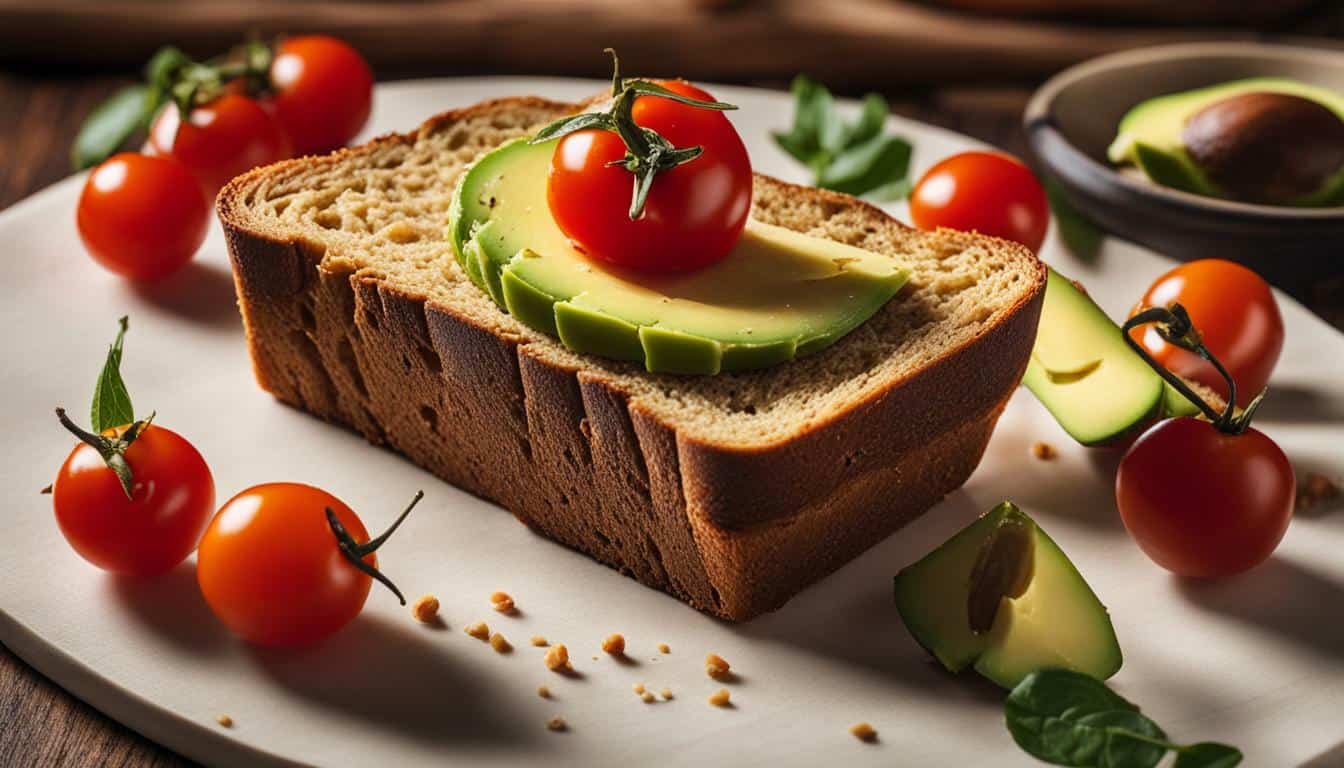



Leave a Reply